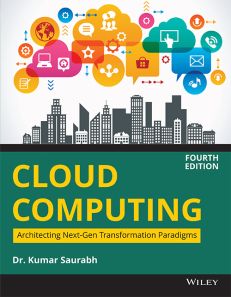Cloud Computing, 4ed: Architecting Next-Gen Transformation Paradigms
ISBN: 9788126570966
296 pages
eBook also available for institutional users
For more information write to us at: acadmktg@wiley.com

Description
The widespread acceptance and deployment of cloud computing describes the means of delivering any and all IT– from computer applications, software, business processes, messaging, and collaboration – to end-users as a service wherever and whenever they need it. This book fulfills an important and growing need to understand the techno-socio-economic view of cloud computing infrastructure, cloud models, service offerings, cloud architectures, and some of the design choices made by the frontiers of cloud computing.
Foreword
Prologue
Preface
Acknowledgements
About the Author
1 First Drive
1.1 Introduction
1.2 Essentials
1.3 Benefits
1.4 Why Cloud?
1.5 Business and IT Perspective
1.6 Cloud and Virtualization
1.7 Cloud Services Requirements
1.8 Dynamic Cloud Infrastructure
1.9 Cloud Computing Characteristics
1.10 Cloud Adoption
1.11 Cloud Rudiments
1.12 Summary
2 Cloud Deployment Models
2.1 Introduction
2.2 Cloud Characteristics
2.3 Measured Service Accounting
2.4 Cloud Deployment Models
2.5 Security in a Public Cloud
2.6 Public Versus Private Clouds
2.7 Cloud Infrastructure Self-Service
2.8 Summary
3 Cloud as a Service
3.1 Introduction
3.2 Gamut of Cloud Solutions
3.3 Principal Technologies
3.4 Cloud Strategy
3.5 Cloud Design and Implementation Using SOA
3.6 Conceptual Cloud Model
3.7 Cloud Service Defined
3.8 Summary
4 Cloud Solutions
4.1 Introduction
4.2 Cloud Ecosystem
4.3 Cloud Business Process Management
4.4 Cloud Service Management
4.5 O n-Premise Cloud Orchestration and Provisioning Engine
4.6 Computing on Demand
4.7 Cloud Sourcing
4.8 Summary
5 Cloud Offerings
5.1 Introduction
5.2 Information Storage

